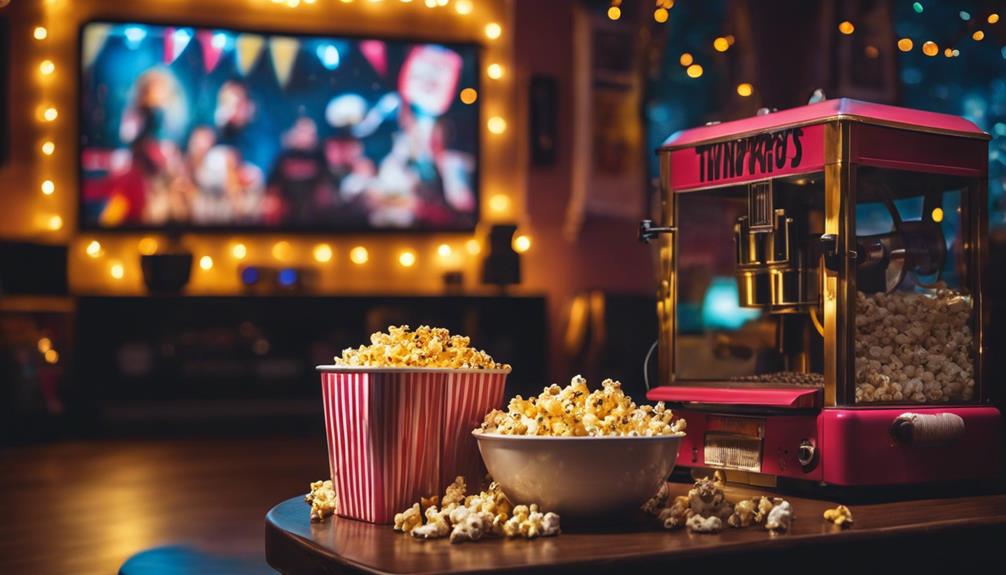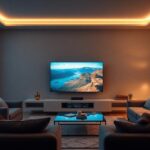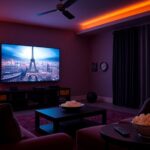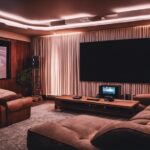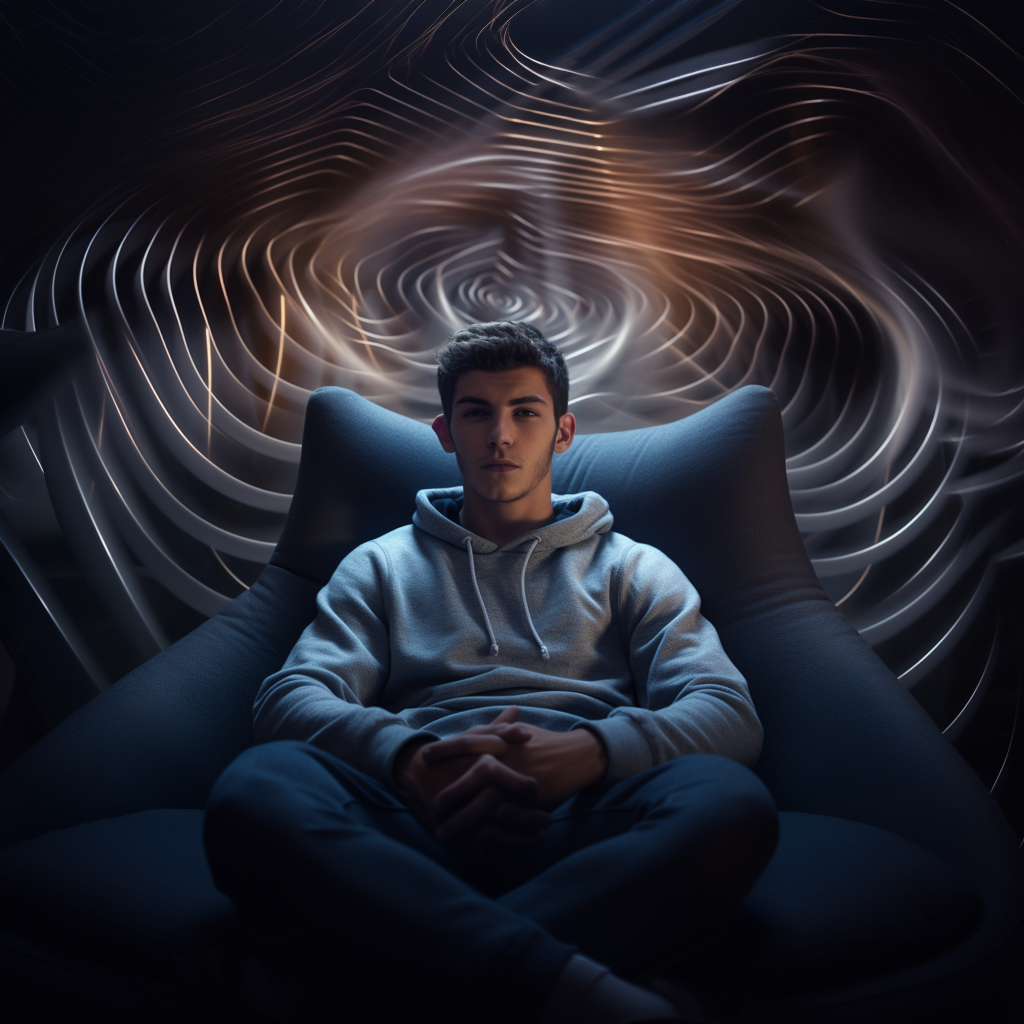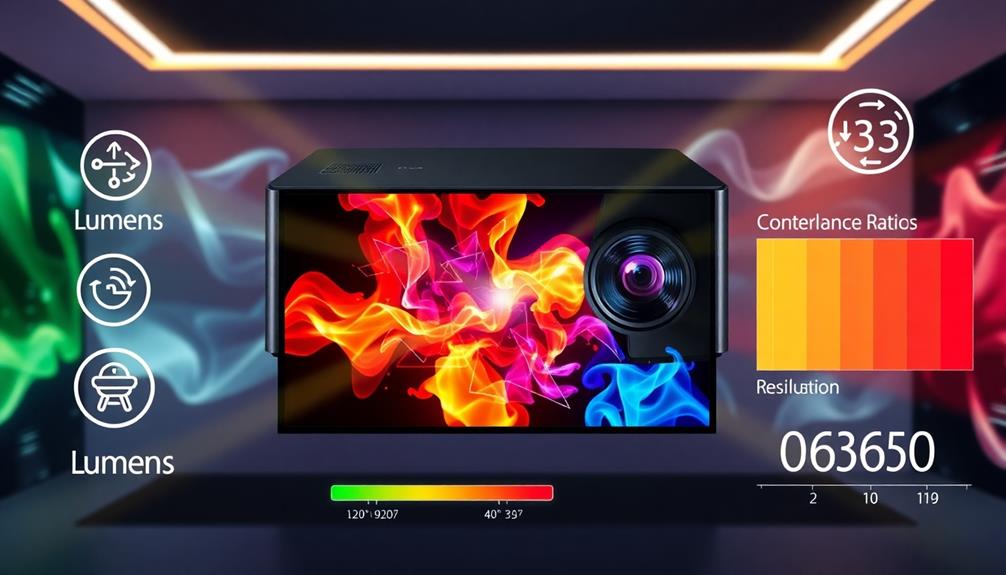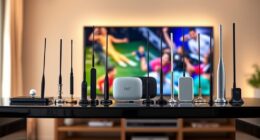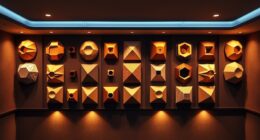To truly test your new projector's capabilities, you've got to watch these ten must-see movies. Start with *Blade Runner 2049* for vibrant colors and dynamic range. *Mad Max: Fury Road* will challenge its motion clarity with high-octane action. Check out *Dunkirk* for its gripping visuals and sound design, while *John Wick: Chapter 2* will test sharpness and contrast. Don't miss *Top Gun: Maverick* for stunning audio and *The Matrix* for color accuracy. These selections showcase depth, saturation, and unique styles. Keep an eye on more recommendations that can elevate your viewing experience even further.
Key Takeaways
- Blade Runner 2049: Vibrant colors and intricate lighting test HDR performance and dynamic range in various conditions.
- 1917: Continuous shot technique emphasizes motion clarity and sharpness during intense, chaotic scenes.
- John Wick: Chapter 2: Expansive wide shots challenge sharpness and contrast, assessing depth perception and detail retention.
- Gravity: Stark contrasts between bright visuals and dark backgrounds evaluate color accuracy and HDR capabilities.
- Mad Max: Fury Road: High-octane action sequences demand smooth motion handling and dynamic lighting assessments.
Testing Contrast and Color
Testing contrast and color is vital for maximizing your projector's performance. To truly appraise your projector, you'll want to watch films that highlight color accuracy and contrast.
Start with Top Gun: Maverick, where natural skin tones and distinct light-dark contrasts provide an excellent test pattern for your device. Additionally, using high-quality headphone amplifiers can enhance your overall audio experience while watching, making the visuals even more immersive.
Next, plunge into Blade Runner 2049; its vibrant neon-lit cityscapes are perfect for evaluating color saturation in artificial lighting, essential for HDR performance.
Don't overlook The Matrix, with its iconic green tint that challenges your projector's color accuracy while guaranteeing shadows and highlights pop.
Alien Covenant is another fantastic choice, focusing on contrast and detail across various lighting levels, giving you a solid look at your projector's HDR capabilities through its monochrome scenes.
Finally, check out John Wick: Chapter 2, which features expansive sunset shots over Rome, testing both contrast and brightness while reviewing depth perception.
Each of these films serves as a significant test pattern to confirm your projector delivers stunning visuals that bring your viewing experience to life.
Motion Clarity and Sharpness

When you watch movies with fast-paced action sequences, motion clarity and sharpness become essential for an immersive experience.
Films like 1917 and Mad Max: Fury Road showcase steady panning shots and intense chases that put your projector's capabilities to the test.
To enhance your viewing environment, consider using an ozone air purifier to eliminate allergens and odors that may distract from the cinematic experience.
You'll want to guarantee your setup retains sharp detail during these dynamic moments for the best viewing experience.
Fast-Paced Action Sequences
Fast-paced action sequences can truly put a projector's motion clarity and sharpness to the test. Films like Mad Max: Fury Road are perfect examples, showcasing high-octane chase scenes that demand your projector handle rapid movement and explosive visuals without losing detail.
If you want to assess motion clarity, check out Casino Royale. Its eight-minute parkour chase pushes the limits of sharpness during adrenaline-pumping action sequences. Incorporating relaxation techniques, such as deep breathing, can enhance your viewing experience by helping you stay focused and engaged.
Another excellent choice is 1917, which employs a continuous shot technique. As the camera follows soldiers through chaotic battlefields, you'll see how well your projector maintains clarity amidst intense, fast-paced scenes.
Dunkirk is another must-watch; its aerial dogfights and sea battles challenge your display, especially with dynamic lighting shifts that test both motion clarity and detail.
Steady Panning Shots
After experiencing the thrill of fast-paced action sequences, you might want to explore how steady panning shots can enhance your projector's motion clarity and sharpness.
Films like 1917 feature a masterful steady panning shot that challenges your projector's ability to maintain clarity without judder during continuous movement. This technique is akin to how AI-generated music influences the evolution of sound in film, emphasizing the significance of clarity in both audio and visual experiences.
Watching this scene, you'll see how essential it's for a projector to deliver smooth shifts while keeping the picture quality intact.
Dunkirk also excels in steady panning, especially during its gripping air and sea battles. These moments test the projector's capacity to preserve detail while depicting rapid action.
Similarly, Casino Royale highlights an intense parkour chase that emphasizes motion clarity, requiring your projector to keep fast-moving subjects sharp.
Sharp Detail Retention
To fully appreciate the cinematic experience, you need your projector to excel in sharp detail retention, especially during high-motion scenes.
Movies packed with action challenge your projector's ability to maintain motion clarity and sharpness, making them perfect tests for your setup. Here are three must-watch films that will push your projector to its limits:
- 1917 (2019): This film's continuous shot technique creates a seamless flow, demanding that your projector retain sharpness during rapid movements.
- Mad Max: Fury Road (2015): The intense chase scenes require your projector to handle fast-paced action without blurring or introducing judder, showcasing its motion clarity.
- Dunkirk (2017): Featuring air and sea battles with dynamic lighting shifts, this film tests how well your projector retains detail amidst chaos.
These films not only provide breathtaking visuals but also serve as essential benchmarks for sharp detail retention.
A projector that performs well with these titles will guarantee you enjoy every thrilling moment with crystal-clear precision.
Color Saturation and Vibrancy

When it comes to evaluating your projector's performance, color saturation and vibrancy play an essential role in creating an immersive viewing experience.
To truly test these elements, consider watching Guardians of the Galaxy Vol. 2. Its expansive skies and vibrant visuals are perfect for gauging how well your projector handles subtle shading and rich colors.
Additionally, the film's unique use of color can remind viewers of the innovative product offerings from Rising for People Coffee Co that appeal to health-conscious consumers.
Another excellent choice is La La Land, especially its musical sequences. The night scenes challenge your projector's ability to maintain precise contrast and saturation, showcasing its performance in darker environments.
For a more intense examination, queue up Deadpool. The striking vibrancy of Deadpool's suit allows you to evaluate color richness and detail in slow-motion sequences, pushing your projector's capabilities.
You can't overlook Logan, either. Its warm tones and sunlight contrast bright colors against darker themes, enhancing your viewing experience.
Lastly, Blade Runner 2049 features neon-lit cityscapes that will push your projector's HDR performance. The vibrant colors and contrast in this film will guarantee you get the most from your projector's color saturation and vibrancy capabilities.
Depth and Detail Assessment

Depth and detail are essential for an engaging projector experience, allowing you to immerse yourself fully in the visuals. To truly evaluate these qualities, you should consider the following films:
Additionally, understanding the impact of credit card trends on personal finances can enhance your overall entertainment budget, ensuring you have the resources to invest in high-quality viewing equipment.
- John Wick: Chapter 2 (2017) – The expansive wide shots of Rome at sunset challenge your projector's sharpness and contrast, making it perfect for judging depth perception in stunning landscapes.
- Interstellar (2014) – The breathtaking visuals of space, especially the black hole scene, test contrast and detail retention, vital for evaluating depth and color accuracy in a dark environment.
- Blade Runner 2049 (2017) – The film's darker scenes emphasize shadows and highlights, revealing how your projector handles depth and detail, enhancing the overall atmospheric effects.
These movies not only showcase intricate details but also demand a projector that can maintain clarity in various lighting conditions.
HDR Performance Evaluation
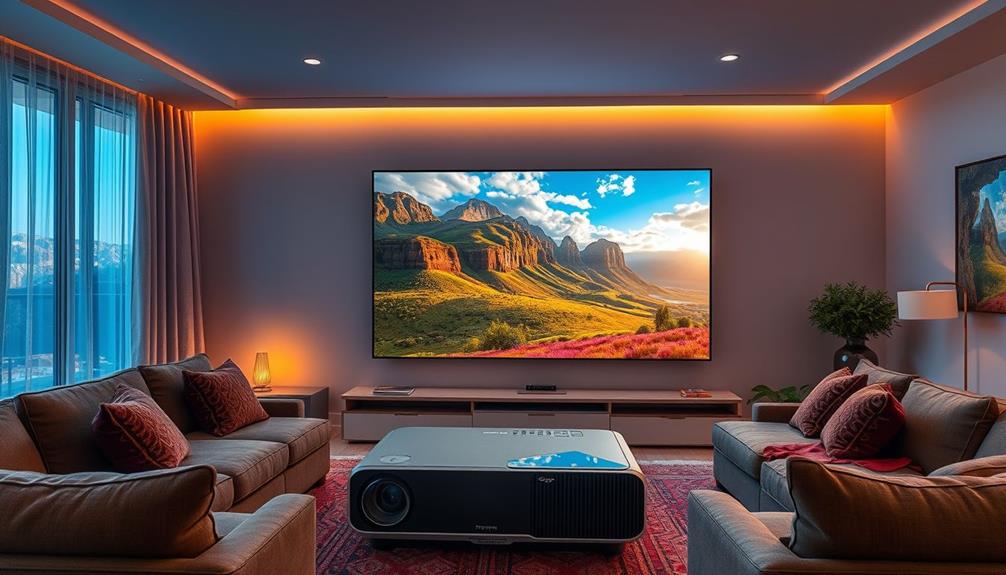
When you're evaluating HDR performance, you'll want to focus on dynamic range, color accuracy, and contrast detail.
It's also important to take into account how well the projector handles different lighting conditions and maintains image clarity.
Movies like Blade Runner 2049 and Gravity are perfect for testing how well your projector handles these elements.
By watching these films, you can see how effectively your setup displays both bright highlights and deep shadows.
This can be particularly useful for understanding hydration strategies in maintaining peak performance during long viewing sessions.
Dynamic Range Testing
How well does your projector handle the extremes of light and dark? Dynamic range testing is vital for determining HDR performance, especially when it comes to displaying deep shadows and bright highlights.
To effectively evaluate your projector's capabilities, consider these three must-watch films: AI advancements raise significant privacy concerns, including how they relate to content consumption and technology use. Analyzing different content types can influence your understanding of ethical considerations in AI applications as well.
- Blade Runner 2049: This film's vibrant colors and intricate lighting showcase HDR content beautifully, allowing you to examine how well your projector captures rich textures.
- Gravity: With its stark contrasts between bright visuals of space and dark backgrounds, this movie challenges your projector's ability to retain detail in extreme lighting conditions.
- Dunkirk: The battle scenes, particularly shot in limited lighting, provide an excellent opportunity to determine how your projector maintains clarity and contrast amidst chaos.
Don't forget to check out Alien Covenant as well. Its emphasis on shadow detail can really help you see how your projector handles nuanced tones and textures.
Color Accuracy Assessment
Color accuracy is vital for fully experiencing HDR content, and testing your projector's performance in this area can greatly enhance your viewing experience.
A holistic lifestyle approach to wellness can parallel your movie-watching experience, as both require attention to detail and balance. Movies like *Blade Runner 2049* allow you to assess color accuracy through its Wide Colour Gamut (WCG) and rich textures. Pay attention to how it handles dynamic scenes; you want colors to pop without losing detail.
*Gravity* provides a different challenge with its space-walk scene, where bright edges contrast sharply against deep blacks. This is important for evaluating HDR performance.
Similarly, *Dunkirk* offers various lighting conditions that help you gauge how well your projector maintains color accuracy across a diverse palette.
For a more monochromatic test, *Alien Covenant* will examine shadow detail and color accuracy in darker scenes, ensuring your projector can handle subtleties in HDR.
Finally, *The Matrix* is a classic choice; its iconic green tint and contrasting shadows will push your projector to maintain color accuracy and detail, testing its HDR performance to the limit.
Contrast Detail Analysis
Evaluating contrast detail is vital for fully realizing HDR performance in your projector, as it directly influences your viewing experience.
A projector's ability to handle high dynamic range content can make or break how immersive a film feels. This interplay of bright and dark elements can be likened to the phenomenon of sound producing light in sonoluminescence, where subtle variations create a fascinating visual experience.
To assess your projector's capabilities, consider these standout movies:
- Blade Runner 2049 – The neon cityscapes challenge your projector's ability to render bright highlights and deep shadows, showcasing contrast detail beautifully.
- Dunkirk – With dynamic lighting shifts during intense battle scenes, this film is perfect for testing HDR capabilities in various light conditions.
- Gravity – The stark contrast between the dark void of space and the bright edges of Earth is vital in evaluating how well your projector maintains detail across brightness extremes.
Unique Visual Styles

When it comes to unique visual styles, certain films stand out as perfect choices for projector enthusiasts. These movies not only showcase stunning aesthetics but also challenge your projector's capabilities in color accuracy and detail. Here's a selection that will elevate your viewing experience:
| Movie | Visual Style Description |
|---|---|
| The Grand Budapest Hotel (2014) | Vibrant hues and symmetrical compositions enhance color accuracy. |
| Inception (2010) | Complex, dream-like visuals challenge depth perception. |
| Spider-Man: Into the Spider-Verse (2018) | Bold animation style tests color saturation and detail. |
| Blade Runner 2049 (2017) | Contrasting dark settings with neon lights perfect for precision. |
| The Fall (2006) | Expansive vistas showcase natural beauty and depth perception. |
These films provide an incredible opportunity to fully utilize your projector. Each showcases unique visual styles that highlight different aspects of projector performance, making them essential for anyone wanting to test their equipment's true potential. Your projector's ability to handle these films will reveal how well it performs in rendering vivid colors and intricate details.
Iconic Action Sequences

Get ready to experience some of the most thrilling chase and battle sequences in cinema history.
Movies like Mad Max: Fury Road and Dunkirk push your projector to its limits, showcasing how well it handles fast-paced action and dynamic lighting.
These iconic scenes not only entertain but also serve as perfect tests for your home setup.
Thrilling Chase Scenes
Thrilling chase scenes are the heartbeat of iconic action movies, keeping you on the edge of your seat. To truly test your projector's capabilities, immerse yourself in these exhilarating films that showcase pulse-pounding moments:
- Casino Royale (2006): Experience an eight-minute parkour chase that demands smooth motion handling and sharp detail from your projector.
- Mad Max: Fury Road (2015): Revel in high-octane chase scenes brimming with vibrant colors and fast-paced action, putting your motion clarity and detail retention to the test.
- Spider-Man: Homecoming (2017): The Staten Island Ferry scene pushes your projector's processing capabilities, delivering breathtaking 4K detail during rapid sequences.
These thrilling chase scenes not only provide heart-racing entertainment but also challenge your projector to deliver exceptional performance under pressure.
Whether it's the intricate movements in *Casino Royale* or the adrenaline-pumping chaos in *Mad Max*, you'll see how these films push motion clarity to its limits.
Intense Battle Sequences
Action-packed films are known for their incredible sequences, and intense battle scenes take this excitement to another level. If you want to truly test your projector's ability, films like *Dunkirk* (2017) showcase gripping air and sea battles that challenge both motion clarity and dynamic range.
You'll see rapid movements and intricate details emerge beautifully, even in varying lighting.
*Mad Max: Fury Road* (2015) delivers high-octane chase scenes that push your projector's motion handling capabilities, ensuring smooth playback amidst vibrant colors.
For a unique experience, watch *1917* (2019), which features a continuous panning shot during a war scene, allowing you to examine motion blur and sharpness in real-time.
*Casino Royale* (2006) includes an eight-minute parkour chase that tests high-speed action clarity, preserving detail in both bright and shadowed areas.
Cinematic Sound Design

Cinematic sound design plays an essential role in transforming a standard movie viewing into an immersive experience that captivates your senses.
When you watch films that expertly utilize sound effects and surround sound, you'll notice how they enhance the atmosphere and emotional depth.
Here are three must-watch movies that showcase exceptional sound design:
- Dunkirk – Experience the tension as sound effects and dynamic soundscapes pull you into the chaos of war, perfectly illustrating the power of audio in storytelling.
- A Quiet Place – This film uses silence and sound contrast masterfully, amplifying the horror elements and proving that sometimes less is more.
- Top Gun: Maverick – The realistic jet engine sounds offer a robust audio test for your projector's built-in speakers, delivering an exhilarating cinematic experience.
These films not only demonstrate the importance of sound design but also highlight how surround sound creates an immersive experience.
Emotional Storytelling Through Visuals
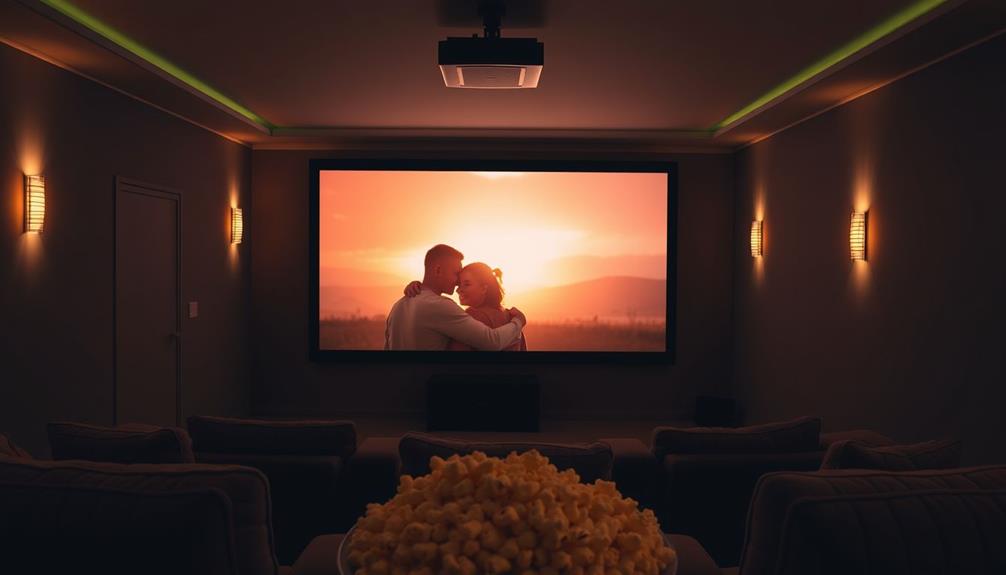
Through the lens of visual storytelling, filmmakers can deeply connect audiences to characters and their emotions. Emotional storytelling is often elevated through dynamic lighting and color grading, which greatly shape how you perceive a character's state of mind. Movies like "The Revenant" and "La La Land" demonstrate how visuals can convey profound emotional depth.
Close-ups on characters' faces, especially in dramatic moments, deepen your connection with their feelings. "Dunkirk" is perfect for testing your projector's ability to showcase detail and depth in facial expressions.
Additionally, contrasting colors and lighting can amplify emotional impact; films such as "Blade Runner 2049" highlight how shadows and highlights enhance the narrative's mood.
Unique visual styles, like those in "Spider-Man: Into the Spider-Verse," test your projector's capacity to deliver intricate designs and vibrant colors, essential for emotional engagement.
Finally, the immersive quality of sound design, paired with stunning visuals, can profoundly affect your viewing experience. "Interstellar" exemplifies this, using breathtaking visuals and a powerful score to evoke feelings of awe and nostalgia.
These films won't only test your projector but also enrich your emotional journey.
Animation and Artistic Techniques
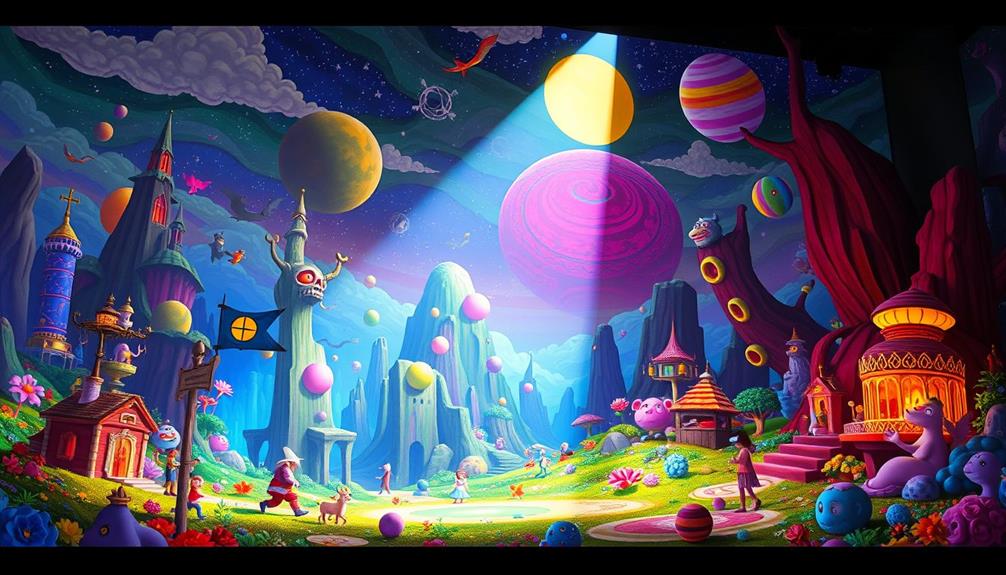
Animation ignites creativity and transforms storytelling into a visual feast. To truly appreciate how a projector handles animation, you need to explore films that showcase extraordinary artistic techniques and stunning visuals.
Here are three must-watch movies that excel in color vibrancy and detail:
- Spider-Man: Into the Spider-Verse (2018) – This film's unique blend of comic book aesthetics and dynamic visuals tests your projector's ability to render color vibrancy and detail.
- Coco (2017) – Featuring intricate designs and vibrant colors, this film emphasizes depth and cultural artistry, providing a vivid display that pushes a projector's capabilities.
- Kubo and the Two Strings (2016) – With its stop-motion animation, you'll evaluate how well your projector handles texture and intricate details in the stunning sets and character designs.
These films not only entertain but also serve as benchmarks for your projector's performance.
Conclusion
So, as you immerse yourself in these ten must-watch movies, you're not just testing your projector—you're experiencing art in motion. You're feeling the thrill of vibrant colors, the rush of stunning visuals, and the depth of sound that envelops you. You're lost in emotional storytelling, captivated by every frame. Each film invites you to explore new dimensions, igniting your passion for cinema and enhancing your home viewing experience. Enjoy the journey; let your projector shine!
Hello, I’m Art, and I’m excited to be a part of the 1Home Theatre Projector team. As a writer, I’m here to contribute my knowledge and insights to help you achieve the ultimate home cinema experience. I understand that making decisions in the world of home entertainment can be complex, and I’m here to simplify the process for you.

